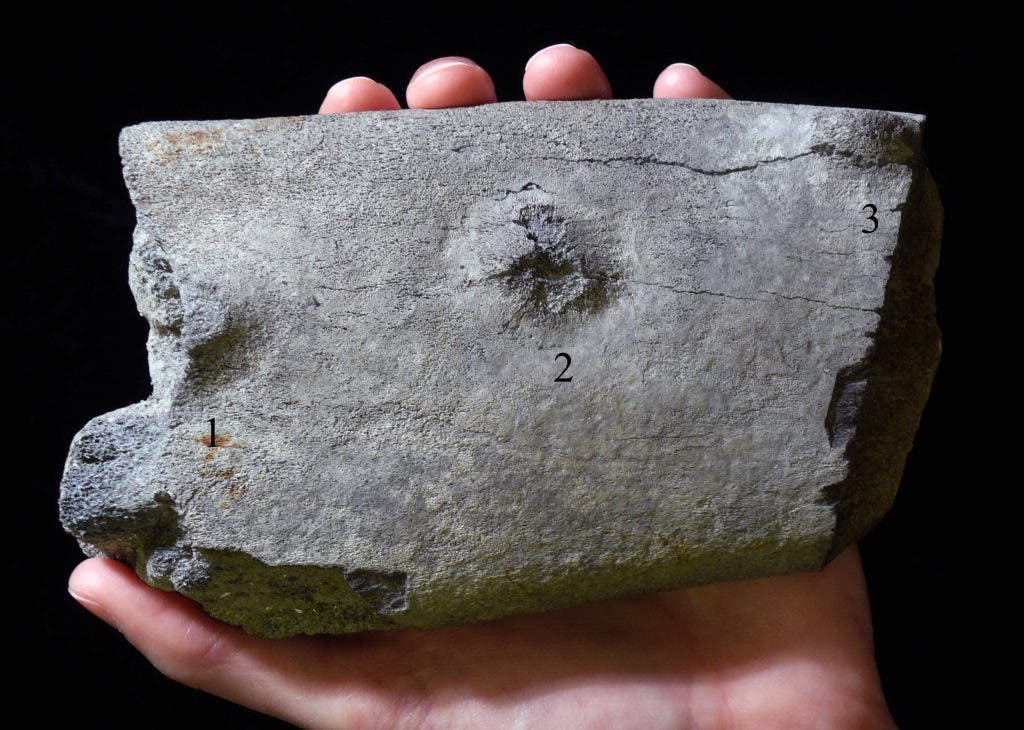Three tooth marks on the rib indicate the whale was once severely bitten by a strong-jawed animal. Judging by the 6-centimeter (2.4 inch) spacing between tooth marks, scientists believe the attacker was a mega-toothed shark Carcharocles megalodon, or perhaps another species of large shark that was alive at that time. It’s not clear if the whale managed to escape or not.

Finding fossils that capture moments of interaction between predators and prey is exceptionally rare. Yet, this is precisely what paleontologists have discovered in the rib fragment: three distinct tooth marks that suggest a powerful bite from a strong-jawed predator. The spacing between these tooth marks—approximately 6 centimeters apart—suggests the attacker was none other than the notorious mega-toothed shark, Carcharocles megalodon, or possibly another large shark species that roamed the Pliocene oceans.
Sharks hunt whales
Stephen Godfrey, a paleontologist at the Calvert Marine Museum in Solomons, Maryland, and a Smithsonian research collaborator is at the forefront of this discovery. “One certainly doesn’t expect to find evidence of animal behavior preserved in the fossil record, but this fossil shows just that, a failed predation,” he says. The shark may have inflicted a significant wound, but it failed to deliver a fatal blow. The whale managed to survive the initial attack, as indicated by signs of healing on the rib bone.
What sets this fossil apart is not just the evidence of the bite but the story the bone itself tells about the whale’s struggle for survival. Most of the rib fragment is covered with a type of bone known as “woven bone.”
According to Don Ortner, an anthropologist at the Smithsonian’s National Museum of Natural History, woven bone forms rapidly in response to localized infection or trauma. This type of bone is weaker than the more stable “compact bone” that eventually replaces it. The presence of woven bone suggests that the whale was alive long enough for its body to attempt to heal the wound, likely over two to six weeks following the attack.
CT scans of the fossilized rib reveal further evidence of inflammation in the bone marrow, consistent with an infection. The infection was likely a direct result of the shark bite. While the healing was incomplete, the exact cause of the whale’s demise remains unknown.
Piecing Together a Prehistoric Encounter
The physical evidence on the rib, combined with an understanding of prehistoric marine predators, allows scientists to piece together a plausible scenario. Based on the curvature of the shark’s jaw—suggested by the arc of the tooth impressions—the attacking shark was estimated to be relatively small, between 4 and 8 meters in length. This size range is significantly smaller than the massive 18-meter lengths that some Carcharocles megalodon individuals are believed to have reached, but still formidable by today’s standards.
Timothy Scheirer, an illustrator for the Calvert Marine Museum, created a detailed illustration showing a likely scenario in which a large Pliocene shark might have bitten a massive baleen whale, similar to today’s blue or humpback whales. These huge baleen whales, which could have been ancestors of modern species, would have been common prey for large sharks during the Pliocene, an era when the oceans teemed with marine giants.
The discovery of this fossil offers a rare window into the ancient marine ecosystems of the Pliocene Epoch. During this period, the world’s oceans were rich with a diversity of marine life, including giant sharks, prehistoric whales, and other megafauna. Understanding the interactions between these species helps scientists reconstruct the complex food webs and ecological dynamics that existed millions of years ago.
Fossils that show predator-prey interactions are invaluable because they provide direct evidence of behavior—a fleeting moment in time captured forever in stone. According to Godfrey, “Only a handful of fossils show these kinds of interactions. There are lots of bite marks on fossils showing where the animal died and its carcass was scavenged. This fossil is one of the very few examples that shows a trauma clearly attributed to another animal, yet also shows the victim survived the event.”
The Significance of Failed Predation
Failed predation is as critical to understanding predator-prey dynamics as successful hunts. It illustrates the constant evolutionary arms race between predator adaptations, like powerful jaws and teeth, and prey defenses, such as speed, size, or other protective adaptations. The presence of bite marks and subsequent healing provides a rare opportunity to study how these ancient animals may have responded to such threats, including their physiological and behavioral adaptations.
What makes this discovery even more fascinating is its contribution to our understanding of prehistoric shark behavior. Sharks are often seen as the ultimate predators of the sea, but this fossil suggests that even the most fearsome predators, like Carcharocles megalodon, did not always succeed in their hunts. The fossil shows a failed attempt, indicating that these ancient sharks, much like modern ones, faced challenges when targeting large and potentially dangerous prey.
Understanding how prehistoric sharks hunted and interacted with their environment also provides insights into their extinction. While the exact reasons for the extinction of Carcharocles megalodon remain debated among scientists, the dynamics of predator-prey relationships, competition for resources, and environmental changes all likely played a role. Fossils like this one help paint a more detailed picture of these dynamics.
The study “Bone Reactions on a Pliocene Cetacean Rib Indicate Short-Term Survival of Predation Event” was published in the International Journal of Osteoarchaeology.






